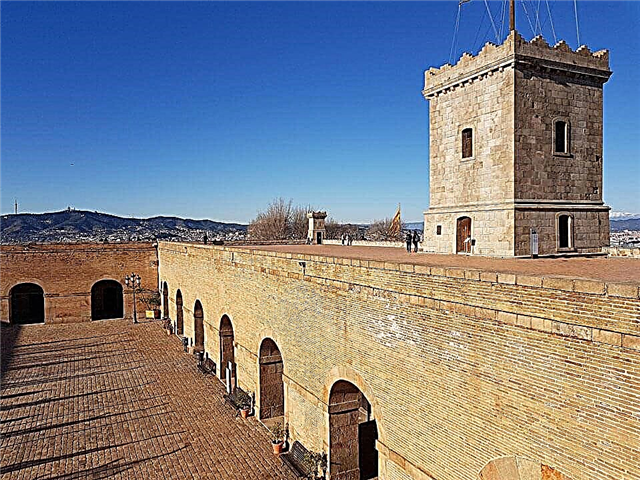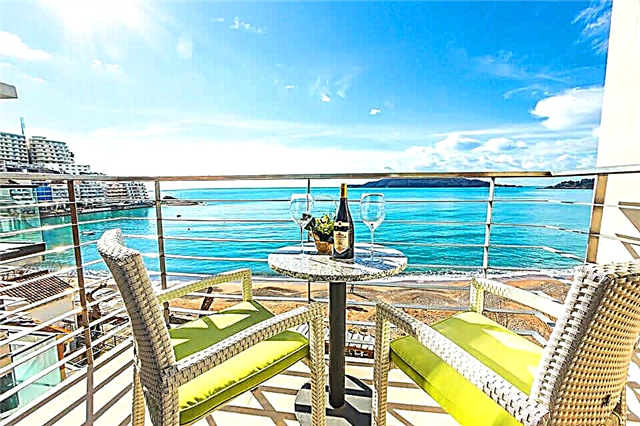Address: Russia, Moscow, Donskaya square
Foundation date: 1591 year
Main attractions: Small Cathedral of the Donskoy Icon of the Mother of God, Large Cathedral of the Donskoy Icon of the Mother of God, Gate Church of the Tikhvin Icon of the Mother of God, Bell Tower, Church of the Archangel Michael
Shrines: Don icon of the Mother of God, the relics of St. Tikhon
Coordinates: 55 ° 42'52.0 "N 37 ° 36'06.7" E
Content:
One of the oldest monasteries in Moscow is located in the historical center of the city. The Donskoy Monastery is surrounded by a green park and stone walls with beautiful patterned towers. Tourists come here to visit the old Donskoy cemetery and see the graves of famous Russians.

Donskoy Monastery from a bird's eye view
Foundation of the monastery
In 1591, the army of the Crimean ruler, the mighty Kazy-Girey, approached Moscow itself. The city was ready for defense, but its inhabitants were preparing for the worst. At the behest of the Russian Tsar Fyodor Ioannovich, a crowded procession was held around the capital. And the tsar sent the famous icon of the Don Mother of God to the defenders of the city, which, according to legend, Dmitry Donskoy had during the famous Battle of Kulikovo.
Then there were several local skirmishes between the Russian warriors and the Tatars, however, the decisive battle never took place. The Tatar troops stayed in the camp for several days and, unexpectedly for everyone, turned back.
The amazing salvation of Moscow caused general joy and jubilation. In honor of the great miracle, the Russian sovereign ordered the founding of a new monastery. And the place for it was the territory of "walk-field", where the mobile army that met the Tatars was located. The Battle of Kulikovo took place on the church feast of the Praise of the Mother of God, so the new monastery was first dedicated to the Mother of God.

View of the towers and walls of the monastery from st. Donskaya
The history of the monastery in the 15th-19th centuries
The monastery immediately built a cathedral dedicated to the icon that saved Moscow. The new stone church was called "refectory", and after the construction of the Great Monastery Cathedral, it was called "Small". Researchers suggest that the famous architect Fyodor Kon 'could have been the architect of the first monastery cathedral, thanks to whom the walls of the White City were built.
The monastery stood to the south of the capital, covering the strategically important Kaluga road. Together with other monasteries, it was part of a fortified ring created to defend the city from enemies.
In the Time of Troubles, the monastery was plundered by the troops of the Poles, led by Hetman Chodkiewicz. After that, the devastated monastery was not restored for several years and was subordinated to the Moscow Andronikov monastery.
The revival of the Donskoy Monastery took place thanks to the efforts of Tsars Mikhail Fedorovich and Alexei Mikhailovich. During their reign, the monastery became popular with pilgrims, and processions of the cross were held through the "pious place", in which ordinary Muscovites, noble boyars and Russian sovereigns participated.

The bell tower of the monastery with the church in the name of Saints Zechariah and Elizabeth
In 1705, the monastery met a new abbot. Peter I entrusted the leadership of the monastery to Archimandrite Lawrence (Gabashvishi). The Moscow monastery began to play the role of a cultural center between Russia and Georgia, and the descendants of the Georgian royal and eminent princely families were buried in the monastery.
In the 70s of the 18th century, a plague epidemic occurred in Moscow, after which it was decided not to bury the townspeople in cemeteries within the city boundaries. Since that time, the monastery necropolis began to grow, and representatives of many famous noble families of Russia - Trubetskoy, Dolgorukov, Vyazemsky, Golitsyns and Naryshkins - found refuge on it.
Like other monasteries in Moscow, the Donskaya monastery was badly damaged during the invasion of Napoleon's troops. True, she was lucky. Despite severe fires, all the monastery buildings remained intact and were quickly restored.
Gradually the monastery became one of the most significant spiritual and educational centers. In 1834, a religious school was opened here, whose graduates could continue their education within the walls of the seminary. It is noteworthy that children from poor families received education free of charge.

Great Cathedral of the Don Mother of God
Monastery in the XX century
The Orthodox monastery is known for the fact that Patriarch Tikhon spent the last years of his life within its walls. After the revolutionary events of 1917, he publicly condemned the atrocities committed and was persecuted for this. The Patriarch was isolated from the flock, and he lived in a monastery.
In the spring of 1925, the disgraced church hierarch was buried in the Small Monastery Cathedral. The monastery was closed the following year. An anti-religious museum was created on its territory. Then a boarding school was opened here, and after that - a factory and a dairy farm.
Since 1935, an architecture museum has been opened on the territory of the monastery. For him from different parts of the city began to bring fragments of old buildings to be destroyed. This is how the high reliefs of the destroyed Cathedral of Christ the Savior, ancient gravestones from dug cemeteries and carved platbands removed from the Sukharev tower got into the former monastery.

Small Cathedral of the Don Mother of God
A few years after the Great Patriotic War, the Small Cathedral was returned to the church, but the monastery itself was not restored. The question of the revival of monastic life was raised in 1982, but several years of discussions did not lead to any result. Only in 1990 did the monastery buildings become the property of the church. After that, large-scale restoration work began here.
What can be seen in the monastery
Visitors enter the monastery through the gates of the high bell tower, which houses the temple of Zechariah and Elizabeth. At the entrance you can see several picturesque hagiographic icons on the walls.
The oldest surviving temple is the Small Cathedral. The new or Great Monastery Cathedral appeared at the end of the 17th century. This was the time when large-scale stone construction was carried out in the monastery. At the same time, powerful walls with openwork towers were erected around the monastery.

Alexander Nevsky Church
Since the end of the 19th century, there has been the Church of St. John Climacus. It was built with the money of General Tereshchenko and served as a family crypt. Another crypt of members of the Zubov family is located in the church of Alexander Svirsky, whose rounded building looks like a classical rotunda.
The picturesque church of St. John Chrysostom became the burial vault of the merchant family of the Pervushins. Another church dedicated to the Tikhvin Icon of the Mother of God completes the northern gate of the monastery.
Most of the monastery territory is set aside for the necropolis. It appeared at the end of the 17th century and by the 19th century had become a place where noble merchants and the elite of the Russian nobility were buried. Close relatives of the poet Alexander Pushkin are at the monastery cemetery.
Here are the graves of the famous Russian mechanic N. Ye. Zhukovsky, the historian V. O. Klyuchevsky and the landowner Saltychikha, known for her cruelty. Among other graves one can see the gravestones of the Russian generals V. Kappel and A. I. Denikin, the philosopher A. Ilyin, as well as the writers I. Shmelev and A. Solzhenitsyn.

Church of St. Tikhon, Patriarch of All Russia
Current state and visiting regime
Today the monastery is active. Divine services are held daily in its churches, and restoration, gold embroidery and icon painting workshops operate on the territory. In addition, a Sunday school for the children of parishioners has been opened at the monastery, and a youth club has been set up for schoolchildren and students.
Tourists and pilgrims can enter the territory of the monastery any day from 7.00 to 19.00. On church holidays, the monastery is closed an hour later.
Shrines
The main shrine of the male monastery is considered to be the Don Icon of the Mother of God (16th century), which was painted by the famous Russian iconographer Theophanes the Greek. The icon revered by believers is constantly in the State Tretyakov Gallery, but once a year it is brought to the walls of the monastery.
In the Big Monastery Cathedral there is a shrine where the relics of Patriarch Tikhon rest. In addition, pilgrims come to pay homage to the burial of Yakov Polozov, who was a cell attendant under Patriarch Tikhon.

Monastic necropolis
How to get to the monastery
The abode is located 5.5 km south of the Moscow Kremlin. The monastic territory is 1.1 km away from the Shabolovskaya metro station, 1.5 km from Leninsky Prospekt and 2 km from Tulskaya. Trams 14 and 39 stop nearby. You need to get off at the stop "Peoples' Friendship University". In addition, the entrance to the monastery can be reached on foot from the side of Leninsky Prospekt - from the public transport stop “Institute im. Kurnakov ".











